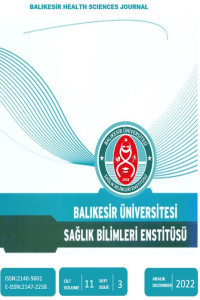Çocuklarda adenotonsillektomiye Güncel Yaklaşım
Adenotonsiller hipertrofi çocukluk yaş grubunda sık görülmektedir. Etkilenen çocuklarda uygun
tedavi ile yaşam kalitesi belirgin artmaktadır. Ameliyat sonrası bazı vakalarda nadir ancak ciddi
komplikasyonlar görülebilmektedir. Bu komplikasyonlar bazen adenotonsiller hipertrofiden
daha tehlikeli sağlık sorunlarına neden olabilmektedir. Bu nedenle operasyona karar vermeden
önce gerekirse uzun süreli izlemi de içeren çok detaylı inceleme gereklidir.
Anahtar Kelimeler:
Adenotonsiller hipertrofi, endikasyonlar
___
- 1. Brodsky L, Koch RJ. Bacteriology and immunologyof normal and diseased adenoidsin children. Arch Otolaryngol Head NeckSurg.1993; 119: 821–829.
- 2. Brodsky L, Moore L, Stanievich JF. A comparison of tonsillar size and oropharyngeal dimensions in children with obstructive adenotonsillar hypertrophy. Int J Pediatr Otorhinolaryngol. 1987;13: 149–156.
- 3. Smith SL, Pereira KD. Tonsillectomy in Children. ORL. 2007; 69:336–339. DOI: 10.1159/000108364.
- 4. Hoşal N, Kaya S, Güney E. Çocuklarda tonsil ve adenoid hiperplazilerinin kardiyopulmoner sistem üzerine olan etkileri.Çocuk Sağlığı ve Hastalıkları Dergisi. 1976; 19: 45-56.
- 5. McGowan FX, Kenna MA, Fleming JA, O'Connor T. Adenotonsillectomy for upper airway obstruction carries increased risk in children with a history of prematurity. Pediatr Pulmonol. 1992; 13: 222-226.
- 6. Ali NJ, Pitson D, Stradling JR. Snoring, sleep disturbance and behaviour in 4–5 year olds. Arch Dis Child. 1993; 68: 360–366. 7. Mallory CB, Fiser DH, Jackson R. Sleep-associated breathing disorders in morbidly obese children and adolescents. J Pediatr. 1989; 115: 892–897. 8. American Academy of Otolaryngology, Head and Neck Surgery:1995 Clinical Indicators Compendium. Alexandria, American Academy of Otolaryngology, Head and NeckSurgery, 1995.
- 9. Paradise JL, Bluestone CD, Colborn DK et all. Adenoidectomy and adenotonsillectomy for recurrent acute otitis media: paralel randomized clinical trials in children not previously treated with tympanostomy tubes. JAMA. 1999; 282: 945–953.
- 10. Coyte PC, Croxford R, McIsaac W, FeldmanW, Friedberg J. The role of adjuvant adenoidectomy and tonsillectomy in the outcome of the insertion of tympanostomy tubes. N Engl J Med. 2001; 344: 1188–1195.
- 11. Richardson MA: Evaluation of tonsils and adenoids in sleep apnea syndrome. Laryngoscope. 1980; 90: 1106–1110.
- 12. Arens R, Mc Donough JM, Corbin AM et all. Upper airway size analysis by magnetic resonance imaging of children with obstructive sleep apnea syndrome. Am J Respir Crit Care Med.2003; 167: 65–70.
- 13. Arens R, Marcus CL. Pathophysiology of upper airway obstruction: a developmental perspective. Sleep. 2004; 27: 997–1019.
- 14. Wiatrak B, Woolley A. Pharyngitis and adenotonsillar disease; In Cummings CW, Haughey BH, Thomas JR, Harker LH, Flint PW (eds): Cummings Otolaryngology, Head and Neck Surgery (4th ed). St Louis, Mosby Inc. 2005.
- 15. Ogden CL, Flegal KM, Carroll MD, Johnson CL. Prevalence and trends in overweight among US children and adolescents 1999– 2000. JAMA. 2002; 288: 1728–1732.
- 16. De la Eva RC, Baur LA, Donaghue KC, WatersKA. Metabolic correlates with obstructive sleep apnea in obese subjects. J Pediatr. 2002; 140: 654–659.
- 17. Brigger MT, Brietzke SE. Outpatient tonsillectomy in children: A systematic review. Otolaryngol Head Neck Surg. 2006; 135: 1–7.
- 18. Fuilleminault CG, Eldridge FL, Simmons FB, Dement WC. Sleepapnea in eight children. Pediatrics. 1976; 58: 23–30.
- 19. Ross RD, Daniels SR, Loggie JM, Meyer RA, Ballard ET. Sleep apnea-associated hypertension and reversible left ventricular hypertrophy. J Pediatr. 1987; 111: 253–255.
- ISSN: 2146-9601
- Yayın Aralığı: Yılda 3 Sayı
- Başlangıç: 2012
- Yayıncı: Balıkesir Üniversitesi
Sayıdaki Diğer Makaleler
Dioksin ve dioksin benzeri kimyasalların toksik etkileri
Şahver Ege HİŞMİOĞULLARI, Adnan Adil HİŞMİOĞULLARI, Tünay KONTAŞ AŞKAR
Çocuklarda adenotonsillektomiye Güncel Yaklaşım
Mustafa KAYMAKÇI, Selçuk YAZICI
Selda YÖRÜK, Türkan ÇALIŞKAN, Hüseyin GÜNDOĞDU
Ankilozan Spondilitli Olguda Anestezi Uygulaması
Özlem SAĞIR, Sabri ÖZASLAN, Yücel MERİÇ, İsmail ARSLAN, Ahmet KÖROĞLU
Karaciğer Transplantasyonu Sonrası Hastaların Yaşadığı Sorunlar ve Hemşirelik Girişimleri
